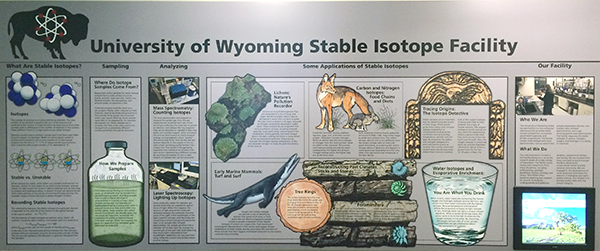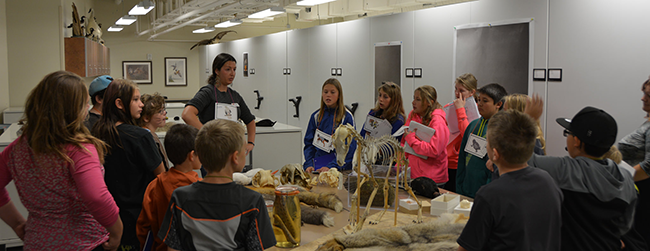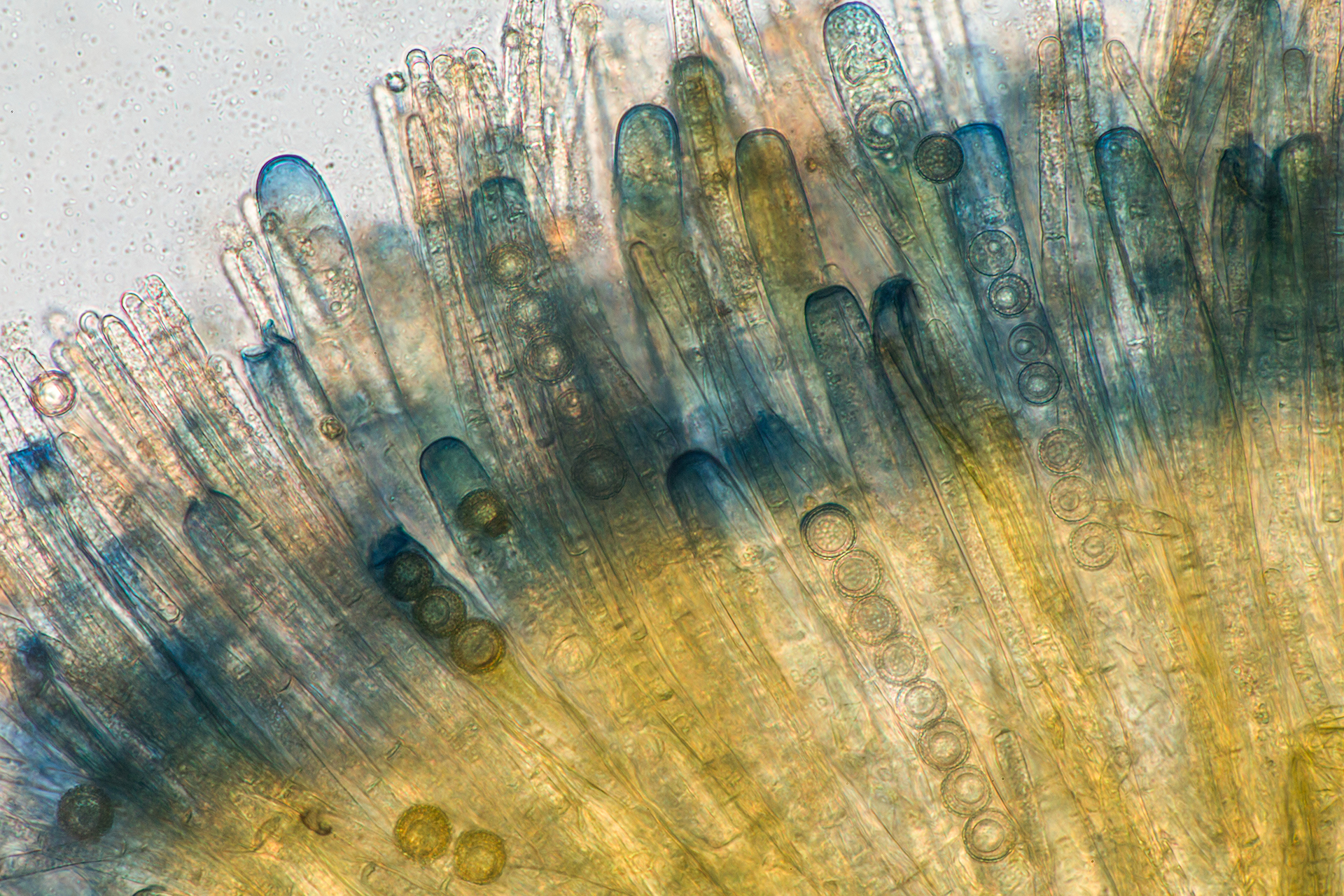Outreach
Plan Your Visit
The Biodiversity Institute at the Berry Biodiversity Conservation Center designed to be a resource for anyone interested in plants, animals, and fungi native to Wyoming (and beyond). From our public programs to our exhibit-filled building, you are welcome to participate in whatever you'd like! Educators can also explore our education pages for deeper information on our education programs.
The Biodiversity Institute at the Berry Biodiversity Conservation Center offers a unique science experience for visitors of all kinds. The Berry Center hosts an assortment of interactive science exhibits and artworks in the halls and around the grounds of a working scientific facility. Windows on to Laboratories and Scientific Collections allow visitors to witness the process of science while learning more about the work and process through interactive displays. Additionally, the Biodiversity Institute hosts fantastic special exhibitions, performances, workshops, and lectures, all open to the public and generally free of charge. Learn more about what's going on at the Berry center below and come visit up today!
Educators, Organizations, and Families
Groups of all varieties can get something out of a visit to the Berry Center. The building includes fun exploration tools, like display cases filled with bug boxes and preserved animals, animal tracks on the floors, exhibits on everything from natural history to stable isotopes, and a space built especially for young children.
We also create and deliver lessons for school groups and organizations that visit would like the Biodiversity Institute to come to them.
Events, Activities, & Programs
There is always something happening at the Berry Center! The Biodiversity Institute hosts movie nights, concerts, dance performances, public speakers, Science Cafe nights, and more. Our community science programs are another great way for families and groups to get involved - outdoors! If you're interested in frogs and toads, moose, monarchs, or milkweeds, we have the programs for you, your school, your family.
Facilities & Exhibitions
The Biodiversity Institute at the Berry Biodiversity Conservation Center offers fun and informative exhibits presented in interactive worlds. Through hands-on experiences throughout the building, you'll learn about science collections, biodiversity science, the evolution of living things, and more. The Biodiversity Institute also features fantastic special exhibitions that change all the time, so visit often to find out what's new!
The Biodiversity Institute Science Exhibits

The Biodiversity Institute Science Exhibits explore and explain some of the research and interests of biodiversity science and scientists--from atoms to scientific collections, to the organisms and landscapes of Wyoming. Learn about why keeping specimens of plants and animals is important, explore the evolution and diversity of life, or become familiar with the raptors of our state. Exhibits are located on all three floors of the building, and even outdoors.
Laboratories & Collections
The Berry Center was constructed to hold a variety of laboratories and collections, in addition to serving as an educational, cultural, and administrative space. The labs and collections listed below can all be viewed by walking through the building. Though most of these facilities limit access because they are working laboratories and may contain chemicals or other materials not safe for the public, arrangements for groups can be made to tour these facilities.
UW Museum of Vertebrates

The mission of the Vertebrate Museum is to document and understand regional and global vertebrate diversity through the acquisition and investigation of collections made by faculty, staff, and students to advance academic knowledge and public appreciation of the natural world.
The scientific information contained in museum research collections contributes to our understanding of the mysteries of the natural world. The specimens housed in the vertebrate research collections of the Berry Center help researchers explore the processes that influenced the evolution of these mysteries.
Kids' Corner
Take a morning or an afternoon and bring your children to the Kids' Corner, a place for 3 to 10-year-olds to play and learn. Complete with books, puzzles, art supplies, and animals, children are welcome to visit at any time, with adult supervision.
WYNND - Wyoming Natural Diversity Database
WYNDD is Wyoming's best resource for information on Wyoming plants, animals, and ecosystems, particularly Wyoming species that are rare or threatened. They maintain a huge database of where and when these species are sighted, how their distributions change over time, their influences on related species and environmental processes, how they react to changing conditions, and more. WYNDD ecologists are great resources related to field research, data synthesis, mapping and GIS, and networking with biologists throughout the state and region.
The Biodiversity Gardens
The Biodiversity Institute maintains three biodiversity gardens around the Berry Center, each highlighting different components of Wyoming’s native flora.
Berry Prairie Green Roof. The Berry Prairie, our roof garden, features nearly 100 species of plants, native to within 200 miles of Laramie. Mimicking the local prairie with abundant grasses and a diversity of herbs and shrubs, this garden is a model for plant selection for the green roof industry, as well as a synthetic ecosystem for the study of urban biodiversity. Located on the east side of the Berry Center.
The Penstemon Garden. The Penstemon Garden was planted in 2012 and showcases many examples of this large genus of North American wildflowers. Penstemon is a great example of pollinator-driven divergence among closely-related species. The result is impressive and beautiful! Located on the west side of the Berry Center.
Indian Paintbrush Garden. Wyomingites know Indian paintbrush as our state flower. Several species can be seen in our Indian Paintbrush Garden, which was planted in the summer of 2013. Indian paintbrushes are much-loved wildflowers but are difficult garden inhabitants because they require a host plant. We are continuing to expand the diversity of paintbrush species and their hosts.
Pollinator Gardens. In 2014, we began the process of establishing several Pollinator Gardens, including one designed especially for butterflies. This summer we will continue to fill in the empty spots, and choose new plants that will feed adult pollinators and provide shelter and food for the larvae, too. We'll be using regionally native plants to attract these beautiful insects, and encourage them to establish families at the Berry Center. Please come by anytime to visit the gardens!
The Ecology Lab (EcoLab)
The Ecology Processing Lab (or "EcoLab") is a multi-functional space for a variety of ecology-oriented students, faculty, and staff that work directly in the field. As groups or individuals return from conducting fieldwork, the EcoLab is a space to conduct processing work such as weighing, sieving, drying, etc. The EcoLab is located directly adjacent to the loading dock doors on the west side of the Berry Center for convenient access and unloading
Upcoming Events:
There are no upcoming events.


